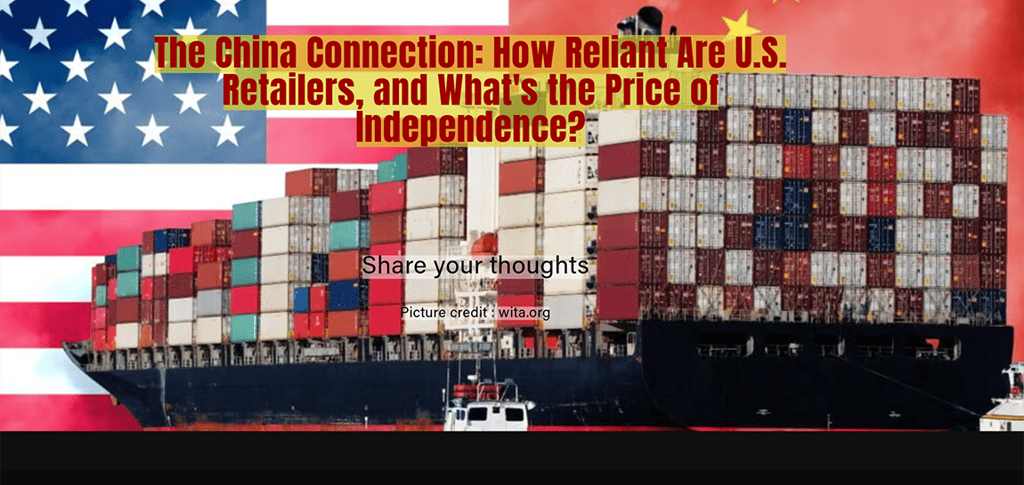The China Conundrum: Can U.S. Retailers Break Free, and at What Cost?
4/22/20253 min read


The China Conundrum: Can U.S. Retailers Break Free, and at What Cost?
For decades, American retailers have leaned heavily on China’s manufacturing prowess to stock shelves with affordable goods. From $10 t-shirts to budget-friendly electronics, China’s low labor costs, vast infrastructure, and slick supply chains have been a boon for U.S. companies and consumers alike. But as tariffs loom, geopolitical tensions simmer, and calls for reshoring grow louder, the question looms: How dependent are we on China, and what’s the true price of cutting ties? Let’s unpack this complex web and explore the stakes.
The Backbone of Bargain Shopping
China’s role in U.S. retail is staggering. In 2022, roughly 30% of U.S. imports came from China, including $500 billion in consumer goods like clothing, electronics, and furniture. This reliance stems from cost advantages: Chinese factories churn out products at a fraction of what domestic production would cost, thanks to lower wages and established supply chains. For retailers like Walmart or Target, this translates to razor-thin margins that keep prices low and profits high. For consumers, it’s the difference between a $15 pair of sneakers and a $40 one.
But it’s not just about cheap goods. American companies have sunk billions into Chinese operations, from factories to logistics hubs. These investments aren’t just profitable—they’re integral to corporate balance sheets and investor returns. In 2023, U.S. firms held over $120 billion in direct investments in China, with retail giants reaping outsized rewards. This entanglement complicates any push for independence.
The Reshoring Reality Check
The idea of “Made in the USA” tugs at patriotic heartstrings, but the road to reshoring is steep. Building domestic factories requires massive upfront costs—think $1 billion or more for a single advanced facility. Specialized machinery, often imported, adds to the tab. Then there’s the workforce: U.S. manufacturers face a shortage of skilled labor, with training programs lagging behind demand. Unlike China’s plug-and-play ecosystem, the U.S. would need years to scale up.
Raw materials are another hurdle. The U.S. imports critical inputs like rare earth metals and textiles, many from China. Going local would spike costs, as domestic alternatives are either scarce or pricier. A 2021 study estimated that reshoring apparel production could double costs, turning that $10 t-shirt into a $20-$25 one. While some shoppers might pay a premium for American-made goods, price-sensitive consumers, especially lower-income households, might balk, curbing spending and risking economic ripples.
Global Competitiveness at Stake
Higher costs don’t just hit wallets; they threaten U.S. companies’ ability to compete globally. If American-made goods become too expensive, exports could tank. In 2023, U.S. exports of manufactured goods hit $1.5 trillion, but competitors like Vietnam and India are already undercutting prices. Forcing retailers to go all-in on domestic production could cede ground to rivals, shrinking market share and jobs.
The Environmental Trade-Off
Reshoring isn’t a green slam dunk either. While U.S. environmental regulations are stricter than China’s, ramping up domestic manufacturing would boost energy use and emissions. New factories could strain local ecosystems, especially in communities unaccustomed to industrial sprawl. A 2022 report suggested that reshoring electronics production could increase U.S. carbon emissions by 10-15% in some sectors. Are Americans ready to trade cleaner air for economic autonomy?
A Balancing Act
Complete decoupling from China is a pipe dream—at least in the short term. Supply chains are too intertwined, and the costs of going it alone are too steep. But incremental steps, like diversifying suppliers to countries like Mexico or Vietnam, could reduce reliance without gutting affordability. Tax incentives for domestic manufacturing, paired with investments in automation, could ease the transition. Public-private partnerships to train workers and rebuild supply chains are another piece of the puzzle.
Consumers have a role too. Are we willing to pay more for “Made in the USA”? Surveys suggest mixed feelings: a 2023 poll found 65% of Americans prefer domestic goods, but only 40% would pay a 20% premium. Businesses, meanwhile, need clarity from policymakers to navigate tariffs and incentives without getting burned.
The Path Forward
The China-U.S. retail relationship is a high-stakes balancing act. Independence sounds noble, but it’s a costly, complex endeavor with no quick fixes. As we weigh the trade-offs, we need honest conversations about what we value: rock-bottom prices, global competitiveness, environmental health, or self-reliance. The choices we make will shape the shelves we shop and the economy we build.
Food for Thought:
Would you pay 20-30% more for American-made goods, or is affordability king?
How much should environmental impact weigh in the push to reshore manufacturing?
What creative policies could help U.S. retailers reduce reliance on China without breaking the bank?
hello@boncopia.com
+13286036419
© 2025. All rights reserved.